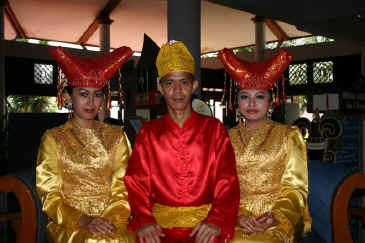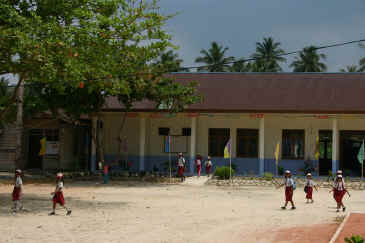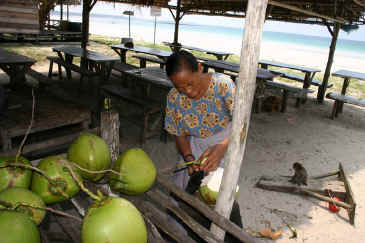|


People
The population
policy is directed toward development of the population as human
resources in order that the national development can be effective
and valuable, while the quality of life is gradually improving.
Meanwhile, control of population growth is carried out through
efforts to lower the birth and mortality rate, especially that of
infants and children. These efforts in particular have been
implemented through family planning programs which also have the
purpose of improving the welfare of mother and child and at the
same time create a small, happy, and prosperous family.

BIRTH RATE
The crude birth
rate is targeted to be reduced from 24.5 per 1000 population in
1993 to 22.6 per 1000 people in 1998. At this rate, the total
population is estimated to increase from 189.1 million people in
1993 to 204.4 million people in 1998. Until February 1997, the
total population was approximately 200 million. In the meantime,
the fertility rate also declined from 4.6 per 1,000 women of
childbearing age in 1980 to 3.3 in 1990.The total fertility rate
is expected to drop from 2.87 in 1993 into 2.60 per woman in 1998.
Several factors
including a rising living standard, higher educational level and
improved health services, contributed to the birth rate decline.
But the greatest proportion is attributable to the increasing
number of people participating in family planning, especially the
new eligible couples. Moreover, contraception has become more
widespread and effective, making it easier to plan families; and
sterilization of men and women has also become more common.

MORTALITY RATE
Life expectancy for
1988 was 63 years, and for 1997 was estimated at 64 years. In 1998
the life expectancy is estimated to increase to 64.6 years.
The crude death
rate in 1988 was 7.9 per 1,000 people against 11.7 per 1,000 in
1983. Furthermore, the crude death rate had decreased about 45.1%
for the period of 1971-1990, and is expected to decrease from 7.9
in 1993 to 75. per 1,000 people in 1998. Meanwhile the infant
mortality rate declined from 90.3 per 1,000 live birth in 1983 to
58.0 in 1988 and is expected to decrease to 50 per 1,000 live
birth in 1998. Causes for the decline in the mortality rate
include better nutrition, a rising standard of living, advances in
medical science, growth of medical facilities, improved health
measures, better working conditions, education in personal
hygiene, and small nuclear families.
THE NATIONALITY
ACT
Indonesian
nationality is governed by Act No. 62 of 1958. It defines an
Indonesian national as a person who, since the beginning of
independence on August 17, 1945, qualifies for citizenship under
the existing laws.
Further, a person
whose mother is an Indonesian national, but whose father's
nationality is unknown or whose father is stateless, shall qualify
for Indonesian citizenship. Also, a person who was born in
Indonesia from unknown parents, or an orphan whose parents are
unknown, or a person born in Indonesia who does not inherit any
nationality from his/her parents, shall qualify for Indonesian
citizenship.
A five year old
child, who is adopted by foster parents of Indonesian nationality,
shall qualify for Indonesian nationality if the foster parents
apply to a court to legitimize the adoption within one year and
request is granted.
A child born from a
legitimate marriage of an Indonesian mother and an alien father
shall, in the event a divorce is granted by the court, qualify for
Indonesian nationality if he/she so decides.
A child born from a
legitimate or illegitimate marriage between an alien father and an
Indonesian mother is entitled to become an Indonesian national if
he/she applies to the Minister of Justice, having abandoned
his/her alien nationality according to the law of the foreign
country or in accordance with an agreement concluded between
Indonesia and a foreign country. In such case a child shall submit
the application within a year after reaching the age of 18.
Back to Top
To obtain the
Indonesian nationality, aliens must fulfill the following
conditions:
-
Have reached the
age of 21 or over;
-
Were born in
Indonesia or have lived in Indonesia continuously for 5 years,
or interruptedly for 10 years;
-
Have a fair
command of the Indonesian language and knowledge of Indonesian
history, and have never been convicted by a court for a breach
of law or for any act against Indonesia;
-
Have the consent
of the wife/husband;
-
Are mentally and
physically healthy;
-
Pay a fee of not
less than Rp500 and not more than Rp10,000, which shall be
decided by the court, taking into consideration the applicant's
income;
-
Have permanent
employment;
-
Have no other
nationality or have abandoned his/her nationality which is in
conformity with an agreement on dual nationality reached between
Indonesia and the foreign country.
An alien married
woman is not entitled to apply for Indonesian citizenship.
However, the Indonesian nationality may be granted to aliens who
have proved meritorious and have served the interest of
Indonesia. Such nationality shall be granted with the approval
of the House of Representatives.
An alien wife of
an Indonesian national is entitled to Indonesian citizenship if
she so wishes and makes a statement to that effect within a year
of the marriage. This does not apply if the husband has
abandoned his Indonesian nationality.
An Indonesian
woman married to an alien husband shall lose her Indonesian
nationality if she makes a statement to this effect within a
year of her marriage.
Indonesian
nationality obtained by a husband shall automatically apply to
his wife except where she, after acquiring the Indonesian
nationality, does not abandon her alien nationality.
If a person loses
his/her Indonesian nationality, his wife/her husband also loses
it, except where both of them are stateless.
A person who has
lost his/her Indonesian nationality by marriage can regain it if
the marriage is broken off and the person applies for it. Such
an application shall include a statement of the divorce and be
submitted to a court or an Indonesian diplomatic mission abroad.
A child under the
age of 18 who is not married and retains his/her kinship with
the father who has not yet acquired the Indonesian nationality,
qualifies for Indonesian nationality if he/she lives permanently
in Indonesia.
If a widow or
widower obtains Indonesian nationality, her/his child shall be
entitled to the same provided that the latter is under 18 years
of age and not married. This also applies to children under 18
and not married, born to parents who have lost their Indonesian
nationality.
Back to Top
Information provided by the Directorate
of Foreign Information Services, Department of Information, Republic of
Indonesia.
|
Population:
|
|
242,968,342 (July 2010 est.)
country
comparison to the world: 4 |
|
|
Age structure:
|
|
0-14 years: 28.1%
(male 34,337,341/female 33,162,207)
15-64 years: 66%
(male 79,549,569/female 78,918,321)
65 years and over: 6%
(male 6,335,208/female 7,968,876) (2010 est.)
|
|
|
Median age:
|
|
total: 27.9
years
male: 27.4
years
female: 28.4
years (2010 est.)
|
|
|
Population growth rate:
|
|
1.097% (2010 est.)
country
comparison to the world: 115 |
|
|
Birth rate:
|
|
18.45 births/1,000 population
(2010 est.)
country
comparison to the world: 106 |
|
|
Death rate:
|
|
6.25 deaths/1,000 population
(July 2010 est.)
country
comparison to the world: 158 |
|
|
Net migration rate:
|
|
-1.23 migrant(s)/1,000 population
(2010 est.)
country
comparison to the world: 164 |
|
|
Urbanization:
|
|
urban population: 52%
of total population (2008)
rate of urbanization: 3.3%
annual rate of change (2005-10 est.)
|
|
|
Sex ratio:
|
|
at birth: 1.05
male(s)/female
under 15 years: 1.04
male(s)/female
15-64 years: 1.01
male(s)/female
65 years and over: 0.79
male(s)/female
total population: 1
male(s)/female (2010 est.)
|
|
|
Infant mortality rate:
|
|
total: 28.94
deaths/1,000 live births
country
comparison to the world: 74
male: 33.76
deaths/1,000 live births
female: 23.89
deaths/1,000 live births (2010 est.)
|
|
|
Life expectancy at birth:
|
|
total population: 71.05
years
country
comparison to the world: 136
male: 68.53
years
female: 73.69
years (2010 est.)
|
|
|
Total fertility rate:
|
|
2.28 children born/woman (2010
est.)
country
comparison to the world: 107 |
|
|
HIV/AIDS - adult prevalence
rate:
|
|
0.2% (2007 est.)
country
comparison to the world: 103 |
|
|
HIV/AIDS - people living with
HIV/AIDS:
|
|
270,000 (2007 est.)
country
comparison to the world: 25 |
|
|
HIV/AIDS - deaths:
|
|
8,700 (2007 est.)
country
comparison to the world: 36 |
|
|
Major infectious diseases:
|
|
degree of risk: high
food or waterborne diseases: bacterial
diarrhea, hepatitis A and E, and typhoid fever
vectorborne diseases: chikungunya,
dengue fever, and malaria
note: highly
pathogenic H5N1 avian influenza has been identified in this country;
it poses a negligible risk with extremely rare cases possible among
US citizens who have close contact with birds (2009)
|
|
|
Nationality:
|
|
noun: Indonesian(s)
adjective: Indonesian
|
|
|
Ethnic groups:
|
|
Javanese 40.6%, Sundanese 15%,
Madurese 3.3%, Minangkabau 2.7%, Betawi 2.4%, Bugis 2.4%, Banten 2%,
Banjar 1.7%, other or unspecified 29.9% (2000 census)
|
|
|
Religions:
|
|
Muslim 86.1%, Protestant 5.7%,
Roman Catholic 3%, Hindu 1.8%, other or unspecified 3.4% (2000
census)
|
|
|
Languages:
|
|
Bahasa Indonesia (official,
modified form of Malay), English, Dutch, local dialects (the most
widely spoken of which is Javanese)
|
|
|
Literacy:
|
|
definition: age
15 and over can read and write
total population: 90.4%
male: 94%
female: 86.8%
(2004 est.)
|
|
|
School life expectancy
(primary to tertiary education):
|
|
total: 13
years
male: 13
years
female: 13
years (2008)
|
|
|
Education expenditures:
|
|
3.5% of GDP (2007)
country
comparison to the world: 134 |
|








